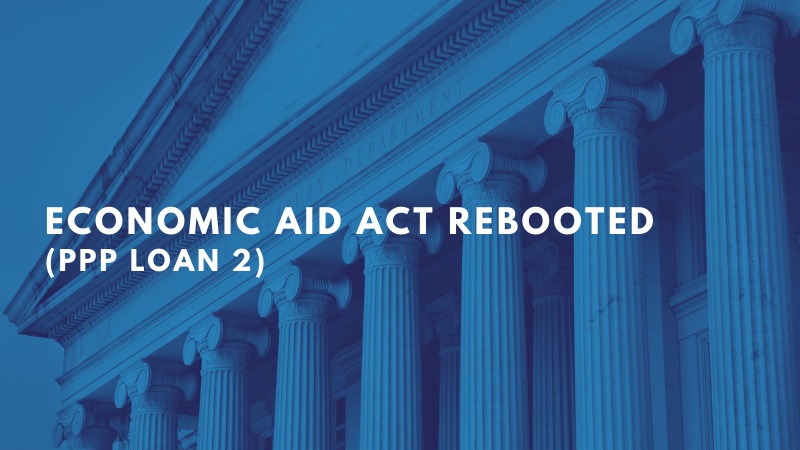
The U.S. Small Business Administration (SBA) and Treasury issued guidance late Wednesday night for the reconstituted Paycheck Protection Program (PPP).
The guidance came in the form of two interim final rules (IFRs):
- The IFR “Business Loan Program Temporary Changes; Paycheck Protection Program as Amended”, which consolidates the rules for PPP forgivable loans for first-time borrowers and outlines changes made by the Economic Aid to Hard-Hit Small Businesses, Nonprofits, and Venues Act.
- The IFR “Business Loan Program Temporary Changes; Paycheck Protection Program Second Draw Loans”, which lays out the guidelines for new PPP loans to businesses that previously received a PPP loan.
Here are some key takeaways of the new program as described in the Economic Aid Act:
Eligible Borrowers for PPP2
Any business concern, non-profit organization, housing cooperative, veterans organization, Tribal business concern, eligible self-employed individual, sole proprietor, independent contractor, small agricultural cooperative, eligible 501(c)(6) organization or destination marketing organization, or an eligible nonprofit news organization that:
- Employs 300 or fewer employees,
- Had a 25% gross revenue decline in any 2020 quarter compared with the same quarter in 2019,
- Previously received a First Draw PPP loan in accordance with the eligibility criteria in the Consolidated First Draw PPP IFR,
- Has used, or will use, the full amount of its First Draw PPP Loan (including the amount of any increase on such First Draw PPP Loan) on authorized uses under subsection (B)(11) of the Consolidated First Draw PPP IFR on or before the expected date on which the Second Draw PPP Loan will be disbursed.
*Please note: Special rules apply if the business was not in operation for all of 2019.
Loan Maximum for PPP2
The max loan is the lesser of:
- $2,000,000, or
- The average monthly payroll costs paid or incurred during either the one–year period before the loan is made or the 2019 calendar year multiplied by 2.5.
- Seasonal employers can choose any 12-week period from February 15, 2019, to February 15, 2020, for determining average monthly payroll costs.
*Note – eligible entities with NAICS 72(hotels and restaurants) codes are able to get 3.5 months, not just 2.5.
Eligible Expenses for PPP2
As with PPP1, the costs eligible for loan forgiveness in PPP2 include payroll, rent, covered mortgage interest, and utilities. PPP2 also makes the following potentially forgivable.
- Covered operating costs such as software and cloud computing services and accounting needs.
- Cost related to property damage and vandalism or looting due to public disturbances that occurred during 2020 that was not covered by insurance or other compensation.
- Covered worker protection and facility modification expenditures, including personal protective equipment, to comply with COVID-19 federal health and safety guidelines.
PPP2 Loan Terms
To be eligible for full loan forgiveness, PPP borrowers will have to spend no less than 60% of the funds on payroll over a covered period of either eight or 24 weeks — the same parameters PPP1 had when it stopped accepting applications in August.
Simplified Forgiveness PPP1
A new one-page loan forgiveness form must be created within 24 days of the date of enactment that satisfies the following:
- For loans up to $150,000, the borrower:
- Provides the number of employees they were able to retain because of the loan,
- The estimated amount of the loan spent on payroll costs,
- Certifies the accuracy of the provided information,
- Complies with other requirements,
- Keeps employment records for four years following loan application submission,
- Keeps other records for three years following loan application submission.
Tax Deductibility of Expenses Paid with Forgiven PPP Funds
Business expenses paid with forgiven PPP loans are tax-deductible. This supersedes IRS guidance that such expenses could not be deducted and brings the policy in line with what the AICPA and hundreds of other business associations have argued was Congress’s intent when it created the original PPP.
Other Notes on PPP1
- PPP funds received and forgiven are excluded from income.
- Repeals the requirement that PPP borrowers deduct the amount of any Economic Injury Disaster Loan advance from their PPP forgiveness amount.
- EIDL advances and grants – Any amounts received are excluded from income are deductible.
- Includes set-asides to support first- and second-time PPP borrowers with 10 or fewer employees, first-time PPP borrowers that have recently been made eligible, and for loans made by community lenders.
- Expands PPP eligibility for certain 501(c)(6) nonprofits and Destination Marketing Organizations with 300 or fewer employees that do not receive more than 15 percent of their revenue from lobbying.
- Expands PPP eligibility to local newspapers and T.V., and radio stations previously made ineligible by their affiliation with other stations.
If you have any questions or concerns as to how these changes may affect your business, please do not hesitate to contact us.
Posted on

